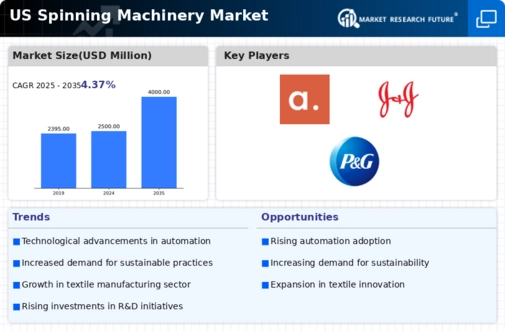Expansion of the Apparel Industry
The spinning machinery market is significantly influenced by the expansion of the apparel industry in the United States. As consumer demand for diverse clothing options continues to rise, manufacturers are compelled to scale up production capabilities. In 2025, the apparel market is projected to reach a valuation of over $400 billion, which directly correlates with the need for advanced spinning machinery. This growth prompts textile producers to invest in state-of-the-art spinning technologies that can accommodate varying fabric types and production volumes. Moreover, the increasing trend of fast fashion necessitates rapid production cycles, further driving the demand for efficient spinning machinery. As a result, the expansion of the apparel industry serves as a vital driver for the spinning machinery market, pushing manufacturers to innovate and enhance their production processes.
Growing Focus on Energy Efficiency
The spinning machinery market is increasingly driven by a growing focus on energy efficiency among manufacturers. As energy costs continue to rise, companies are seeking ways to reduce consumption and minimize their environmental impact. In 2025, it is projected that energy-efficient spinning machinery will account for approximately 40% of the market share. This shift is prompting manufacturers to invest in technologies that optimize energy use, such as advanced motor systems and regenerative braking. Additionally, energy-efficient machinery not only lowers operational costs but also aligns with the broader sustainability goals of the textile industry. As consumers become more environmentally conscious, the demand for energy-efficient products is likely to increase, further driving the spinning machinery market. Therefore, the growing focus on energy efficiency represents a significant driver, encouraging innovation and investment in sustainable spinning technologies.
Increased Investment in Automation
The spinning machinery market is witnessing a surge in investment towards automation technologies. As manufacturers seek to enhance productivity and reduce operational costs, the adoption of automated spinning systems is becoming increasingly prevalent. In 2025, it is estimated that the automation segment within the spinning machinery market will account for nearly 30% of total market revenue. This shift towards automation not only streamlines production processes but also minimizes human error, leading to higher quality outputs. Additionally, automated systems can operate continuously, thereby increasing overall production capacity. The trend towards automation is further supported by advancements in artificial intelligence and machine learning, which enable smarter and more efficient spinning operations. Consequently, the increased investment in automation is a critical driver for the spinning machinery market, as it aligns with the industry's goals of efficiency and quality enhancement.
Rising Demand for High-Quality Textiles
The The spinning machinery market is experiencing a notable increase in demand for high-quality textiles, driven by consumer preferences for premium products. As the textile industry evolves, manufacturers are compelled to invest in advanced spinning machinery to meet these quality standards. In 2025, the market for high-quality textiles is projected to grow by approximately 8%. This necessitates the adoption of innovative spinning technologies. This trend indicates that companies focusing on quality enhancement through superior machinery will likely gain a competitive edge. Furthermore, the integration of automation in spinning processes is expected to improve efficiency and reduce waste. This aligns with the industry's shift towards sustainability. Thus, the rising demand for high-quality textiles is a significant driver for the spinning machinery market, pushing manufacturers to upgrade their equipment and processes.
Technological Integration in Manufacturing
The spinning machinery market is being propelled by the integration of cutting-edge technologies in manufacturing processes. Innovations such as IoT (Internet of Things) and data analytics are transforming traditional spinning operations into smart factories. In 2025, it is anticipated that nearly 25% of spinning machinery will incorporate IoT capabilities, allowing for real-time monitoring and optimization of production. This technological integration not only enhances operational efficiency but also provides manufacturers with valuable insights into production performance. Furthermore, the ability to collect and analyze data enables companies to make informed decisions regarding maintenance and resource allocation, ultimately reducing downtime and costs. Thus, the technological integration in manufacturing is a crucial driver for the spinning machinery market, as it fosters a more responsive and efficient production environment.














Leave a Comment